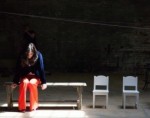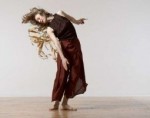
15 Years Remix and Redux
by Kirsten Kaschock
Montréal’s RUBBERBANDance Group is fifteen years old, and it is celebrating that milestone with all the exuberance and bravado that adolescence brings with it. To mark the company's coming-of-age, its founder and choreographer, Victor Quijada, sampled work from the past decade and a half—work that highlights Quijada's melding of the street dance of his Los Angeles youth and the contemporary dance he later performed on concert stages around the world.
The evening, titled Vic’s Mix, begins with a man leaning in a seemingly impossible posture—maybe listening, maybe to his own body. The motif evolves as four men explore a kind of communal puppetry. When one man touches another man’s elbow or chest or forehead, that dancer leans into the point of contact to initiate the next movement. The game starts slow, but as it speeds up, the virtuosic and urban athleticism of these dancers is revealed, as is their gift for the type of illusion one expects at the ballet—effortlessness.
These dancers' lexicon is not strictly, or even recognizably, classical. Victor Quijada has woven out of his history—1990s hip-hop culture followed by a performing career with Tharp!, Ballet Tech/Feld Ballets, and Les Grand Ballets Canadiens de Montréal—a fabric of movement notable for its intertwining partnering, its fulsome litheness, and the skill with which these dancers invert, weight-share, and converse.
Converse, etymologically, means to turn with—and I was reminded of the word’s roots during a moment in the evening when a dancer stops a solo to ask the backstage crew if he can “start over.” He puts on a headset to talk to the guy running the light board, but they have trouble finding his cue. Finally, a partner joins him and they move through a section of the following duet, braiding bodies across the stage. As the two wind through one another, the first dancer talks through the movements as they come, deconstructing the illusion of an emotional pas-de-deux by laying bare the realities of its rehearsal and logistics.
This Penn-&-Teller-type reveal is not shockingly new, but I appreciated its cerebral impact on the rest of the evening. After intermission, the small sections that moved in and out of one another were scored with mostly classical compositions, by Prokofiev, Bach, Vivaldi, Verdi. I began thinking of the history of musicians before recording technology—of how they were often rebels, the punk rockers of their day; of what the music meant to audiences hearing it for the first time, live. A good remix works that way—it lets you listen to omething you know well with new ears. When Quijada alludes to the Romeo and Juliet story with Prokofiev’s iconic strains, he also communicates its universal conflicts through the dancers’ presences. Their threatening at-the-edge posturing and physical braggadocio invoke the gang-like atmosphere (if not the bright costuming) of Baz Luhrmann’s 1996 take on that classic, another re-visioning.
In an excerpt taken from sHip sHop Shape Shifting, intricate phrase-work creates yet another, visual counterpoint for a Bach Partita, and in the final operatic duet (called, punningly, The Traviattle), a male and female dancer go back and forth, embodying the trills and held notes of the male and female voices through their own technical wizardry. The near-literalness of the translation evokes laughter from the audience—not for the first time in the evening.
Quijada seamlessly mines the continuum between percussive movement and more fluid beauty, between the body’s circular logic and its ability to explode, between moments of humor and tenderness and seething tension. These are dynamics I remember experiencing at fifteen. Revisiting them through the work of RUBBERBANDance Group’s dauntless dancers—Amara Barner, Jean Bui, Franklin Luy, Sydney McManus, Zack Tang, Sovann Rochon-Prom Tep, Lavinia Vago, and Paco Ziel—was to remember the joy I felt testing limits, pushing boundaries, exploring my identity through a weaving together of history, raw emotion, and influence.
Vic’s Mix RUBBERBANDance Group, The Prince Theater, October 13-6. http://rubberbandance.com
By Kirsten Kaschock
October 17, 2016










